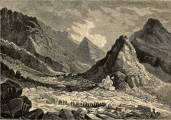


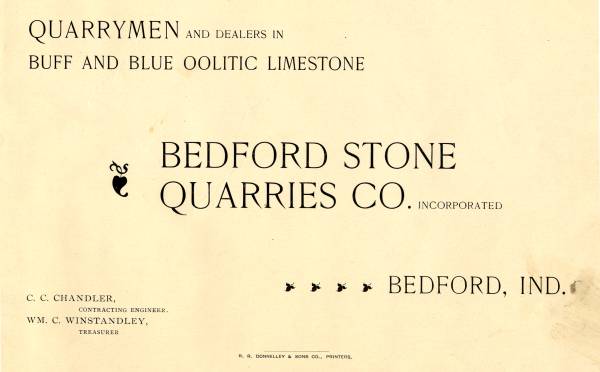
A Glimpse of the Celebrated Stone Quarries at Bedford,
Indiana
Quarrymen and Dealers in Buff and Blue Oolitic Limestone
Property of the Bedford Stone Quarries Co., Inc.
Largest Producers of Oolitic Limestone in the World
(published circa late 1880s to early 1890s)
Bedford Stone Quarries Company
A stranger desiring to visit the quarries of the Bedford Stone
Quarries Company, can reach Bedford, Indiana, via the Ohio and
Mississippi Railway, from St. Louis, Indianapolis, Terre Haute,
Chicago, Louisville,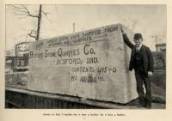 and points North and South; and the Louisville, New Albany and
Chicago Railway, from Louisville or Chicago. Bedford is the capital
of Lawrence County, Indiana, is beautifully situated in a rock
region known as the Oolitic District of Indiana, has about 8,000
inhabitants, and is rapidly growing. It is well supplied with a
complete system of Water works, Electric Lights, etc. By applying
to the offices the Bedford Stone Quarries Company, situated on the
Public Square, adjoining the offices of the Bedford Bank, the
information necessary to reach the Quarries can be obtained.
and points North and South; and the Louisville, New Albany and
Chicago Railway, from Louisville or Chicago. Bedford is the capital
of Lawrence County, Indiana, is beautifully situated in a rock
region known as the Oolitic District of Indiana, has about 8,000
inhabitants, and is rapidly growing. It is well supplied with a
complete system of Water works, Electric Lights, etc. By applying
to the offices the Bedford Stone Quarries Company, situated on the
Public Square, adjoining the offices of the Bedford Bank, the
information necessary to reach the Quarries can be obtained.
The quarries of the Company, consisting of "Hoosier 1 and
2," "Oolitic 1 and 2," "Louisville and
Bedford," and "Buff Ridge," are situated about 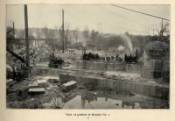 five miles
northwest of Bedford, in what is geographically known as "Buff
Ridge," a district about one mile wide and about three miles
long.
five miles
northwest of Bedford, in what is geographically known as "Buff
Ridge," a district about one mile wide and about three miles
long.
Buff ridge has been very truthfully described as "occupying the relation to the Oolitic Limestone deposit that a hub sustains to its wheel." At this point the deposit of Buff stone shows an unbroken depth of from 40 to 60 feet and a fineness and uniformity of that is abruptly lost in following the strata east and west and gradually lost in a northerly and southerly direction, the stone changing both in color and density from Buff to a hard Bluish and often variegated variety, with here and there a thin upper strata of Buff, but always much harder to manipulate than the strata at Buff Ridge.
Some of these deposits have proven of more and less value, however, producing a fair quality of bridge stone, curbing, flagging stone for street use, and stone for lime and fluxing purposes. But as the product at Buff Ridge is universally recommended for all general purposes, and as the supply is inexhaustible, it must always continue a favorite with architects and builders.
The property of the Bedford Stone Quarries Company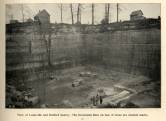 embraces in the neighborhood of 1,000 acres of the choicest of this
deposit, and their quarries are fully equipped with the most
improved machinery, their business requiring the use of twenty
channellers, ten steam derricks, nine gangs of saws, headers,
planers, etc., etc. Large additions are now being made to the
machinery, and it is contemplated in the near future to double the
present capacity.
embraces in the neighborhood of 1,000 acres of the choicest of this
deposit, and their quarries are fully equipped with the most
improved machinery, their business requiring the use of twenty
channellers, ten steam derricks, nine gangs of saws, headers,
planers, etc., etc. Large additions are now being made to the
machinery, and it is contemplated in the near future to double the
present capacity.
The entire Plant is lighted with electricity, and, in the summer season, is operated both day and night.
Access to the Quarries is had through the Bedford Belt Railway, a line of railroad twelve miles in length, which connects with all railroads entering Bedford. The Bedford Belt Railway has three large "Mogul" engines for hauling freight to Bedford from the Quarries, and two smaller engines to do the necessary switching and operate a passenger business between Bedford, Limestone and the Quarries.
The completion of the Bedford Belt Railway, connecting all of the
Quarries at Bedford 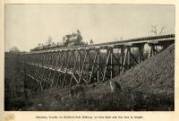 with all of the railroads entering there,
together with present facilities for obtaining a sufficient number
of cars at all times to transport the output, enables the Bedford
Stone Quarries Company to take contracts of any magnitude and to
insure prompt delivery.
with all of the railroads entering there,
together with present facilities for obtaining a sufficient number
of cars at all times to transport the output, enables the Bedford
Stone Quarries Company to take contracts of any magnitude and to
insure prompt delivery.
Some idea of the extensive preparations for shipment of this stone will be gathered from the views presented herewith; nor will the importance of this industry be underestimated when it is known that the cost of the Bedford Belt Railway was something over $25,000 per mile, the topography of the country rendering it a very expensive and difficult piece of engineering.
Bedford Stone has become so popular and is in such demand that an extended description hardly seems necessary, but a few items of interest are here presented:
For over forty years this stone has been known locally. In 1851 it
entered into the construction of the white River Railroad bridge,
near Bedford, with the evidence to show that, during the past
forty-two years of high and low water and exposure, 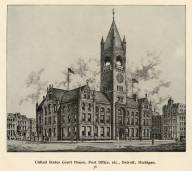 the stone
abutments are as perfect as when built, not a flaw, nor crack in
the stone, nor the slightest appearance of crumbling. It bears an
enormous pressure, and has been pronounced fit material to enter
into the construction of our most substantial public and Government
buildings. Its color is light buff, but when deep quarried it is
blue. The grain is fine and it receives a good polish. It weighs
about 170 lbs. to the cubic foot, and looks admirably in modern
styles of architecture. It can be quarried in larger dimensions
than any other stone; this is exemplified in the large flat stone
required for the Vanderbilt mansion in New York, to transport which
a car had to be specially constructed, and in the accompanying cut.
the stone
abutments are as perfect as when built, not a flaw, nor crack in
the stone, nor the slightest appearance of crumbling. It bears an
enormous pressure, and has been pronounced fit material to enter
into the construction of our most substantial public and Government
buildings. Its color is light buff, but when deep quarried it is
blue. The grain is fine and it receives a good polish. It weighs
about 170 lbs. to the cubic foot, and looks admirably in modern
styles of architecture. It can be quarried in larger dimensions
than any other stone; this is exemplified in the large flat stone
required for the Vanderbilt mansion in New York, to transport which
a car had to be specially constructed, and in the accompanying cut.
The Bedford building stone speaks for itself to any practical builder, geologist or architect. Considering that within the last decade alone has any considerable effort been made to attract public attention to the Bedford Quarries, the results in an acquaintance with the stone and the extent of its use are matters most gratifying to those specifically interested as well as to the public.
The history of stone quarrying at Bedford, Ind., dates back to 1855, when the first Quarry was opened. The second was opened in 1857, the third in 1867, and fourth in 1877.
This stone is of the same Geological Age, and is equal if not superior to the celebrated Portland stone quarried in the South of England. The most substantial buildings in England to-day those which have best resisted the eroding tooth of time, such as St. Paul's Cathedral, Goldsmith's Hall, various public buildings in London, and many other buildings of Queen Anne's time are built of the well known Portland limestone. St. Paul's Cathedral was finished in 1700. The building generally is in good condition, and the carvings of fruits and flowers are nearly as perfect as when first executed. Wells' Cathedral and Chapter House (thirteenth century) are in excellent condition. Wendoush Church (fifteenth century) is splendidly preserved, exhibiting its original tool marks as perfect as when it left the hands of the workmen over 300 years ago.
An Extract from the Report of the State Geologist of Indiana
"By far the most beautiful and valuable stone for architectural purposes is the Oolitic Limestone. The supply is simply inexhaustible, as it lies in massive strata of from twenty to seventy feet thick, over a large area.
These strata are homogeneous, equally strong in vertical, diagonal or horizontal sections. The stone comes from the quarry so soft as to be readily worked by saw, chisel or planing machine, while on exposure it hardens to a strength of from 10,000 to 12,000 pounds to the square inch-a strength amply sufficient to sustain the weight of the largest structure in the world. In use it presents a handsome, creamy brown appearance, gradually whitening with age. It is of almost unprecedented purity, containing an average of 96.8 per cent of carbonate of lime, a purity rarely, if ever, surpassed, and scarcely equalled, in the world. Hence its advantage over the magnesian limestones, as it is not affected by decay in an atmosphere charged with the gases of burning stone coal. In natural outcrop it presents bold perpendicular faces to the elements, showing every scratch and mark, unaffected after the exposure of thousands of years, as no other stone or rock does.
"It is quarried by steam channelers, which carve it out in prisms six by ten, fifty or one hundred feet long, putting to shame the boasted prodigies of Egyptian story and effort. It is then rapidly sawed into blocks and dimension forms, and steam planers carve, mold and smooth it like clay or wood, and more accurately than mallet and chisel. It is now fit to be carved and polished into the freest kind of sculptured and ornamental work.
"Ready for the mason or sculptor, it is alive and resonant,
answering with a clear metallic ring each touch or blow. This
resonance is an excellent test of the perfect unity of its
particles, and as a result it is highly elastic, bending under
pressure and rebounding to place when relieved from it. This
elasticity enables Indiana Oolitic Limestone to adapt itself
without cleavage or disintegration to our changeable climate, where
material will be frequently subject to a change of from 20 degrees
to 60 degrees of temperature in a few hours; as in large buildings
the outside will be subject 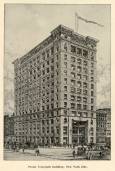 to a temperature of 25 degrees below zero in
winter, or 120 degrees above in the summer, while the inside will
remain at 60 degrees or 70 degrees-difference of 50 to 80 degrees
in the extremities of the same stone-with their accompanying
effects in expansion or contraction. The strains of heat and frost
will tear down buildings and sides of mountains with their great
expansive forces, and even steel and iron will give way before
them. Here, then, is represented to the builder and architect a new
and wondrous element in an 'elastic stone,' a potent quality which,
united with its other sterling excellencies of strength and beauty,
makes Indiana Oolitic limestone the best in the world for exposed
work in buildings in localities subject to great climatic changes.
It has been, and is now being, used in many of the finest public
structures in the country-the new $2,000,000 Court house in
Indianapolis, the new Indiana State house, the post office, and
many churches in that city, the Custom house at Louisville; the
City hall and the water tables of Lincoln Park in Chicago, many
fine structures in St. Louis, the Cotton Exchange in New Orleans,
and many public and private buildings in New York and Philadelphia,
and the exposed parts of the new State house of Illinois."
-from the 13th report of the State Geologist of Indiana,
1883..
to a temperature of 25 degrees below zero in
winter, or 120 degrees above in the summer, while the inside will
remain at 60 degrees or 70 degrees-difference of 50 to 80 degrees
in the extremities of the same stone-with their accompanying
effects in expansion or contraction. The strains of heat and frost
will tear down buildings and sides of mountains with their great
expansive forces, and even steel and iron will give way before
them. Here, then, is represented to the builder and architect a new
and wondrous element in an 'elastic stone,' a potent quality which,
united with its other sterling excellencies of strength and beauty,
makes Indiana Oolitic limestone the best in the world for exposed
work in buildings in localities subject to great climatic changes.
It has been, and is now being, used in many of the finest public
structures in the country-the new $2,000,000 Court house in
Indianapolis, the new Indiana State house, the post office, and
many churches in that city, the Custom house at Louisville; the
City hall and the water tables of Lincoln Park in Chicago, many
fine structures in St. Louis, the Cotton Exchange in New Orleans,
and many public and private buildings in New York and Philadelphia,
and the exposed parts of the new State house of Illinois."
-from the 13th report of the State Geologist of Indiana,
1883..
In addition to operating their own extensive quarries, the Bedford Stone Quarries Company, owning nearly one thousand acres of Quarry land situated at the very heart of Buff Ridge, is prepared to offer extra inducements to Quarrymen to open new Quarries to be operated either at a fixed rental or on royalty. The Quarry sites offered have a uniform strata from 40 to 60 feet of the finest Buff Oolitic Limestone. The stripping is very light, and the output will run not less than 1,750,000 cubic feet to the acre, quarried 40 feet deep. There is an unlimited water supply for milling purposes, together with superior railroad facilities.
PARTIAL LIST OF BUILDINGS CONSTRUCTED OF
BEDFORD STONE.
Public Buildings and Improvements.
- American Fine Arts Society Building, New York City
- Western Union Telegraph Co. Building, New York City
- Wilkes Building, New York City
- Smith Building, New York City
- New York "Times" Building, New York City
- Delaware and Lackawanna Building, New York City
- The Stokes Building, New York City
- Havemyer Building, New York City
- Mail and Express Building, New York City
- German Line Insurance Co. Building, New York City
- London & Lancashire Ins. Co. Building, New York City
- Postal Telegraph & Cable Co. Building, New York City
- Mutual Reserve Fund Building, New York City
- Broadway Railroad Power Building, New York City
- Decker Bros. (Pianos) Building, New York City
- Lincoln Building, New York City
- Bank of North America Building, New York City
- Emigrant Industrial Savings Bank, New York City
- Farmers' Loan & Trust Co., New York City
- The Savoy, New York City
- Harlem Library, New York City
- Colonial Club, New York City
- Dugro Hotel, New York City
- The Holland House, New York City
- Lamb and Rich Block, New York City
- Mercantile Building Co.'s Blocks, New York City
- Majestic Hotel, New York City
- Graham House, New York City
- Graham Apartments, New York City
- Fire Patrol Station No. 5, New York City
- 68th Street School, New York City
- 93rd Street School, New York City
- Ridge Street School, New York City
- Apartment House, 72nd St., bet. 8th and 9th Avenues, New York City
- Fuller Building, New York City
- Camden Block, New York City
- College of Pharmacy, W. 68th St., New York City
- Mutual Life Ins. Co. Building, New York City
- City Hall, Chicago, Illinois
- New County Jail, Chicago, Illinois
- New Public Library, Chicago, Illinois
- New Art Museum, Chicago, Illinois
- New Lincoln Museum, Chicago, Illinois
- New Depot of the Illinois Central R. R. Co. , Chicago, Illinois
- Chicago University Building, Chicago, Illinois
- Standard Club, Chicago, Illinois
- Chicago Athletic Club, Chicago, Illinois
- Lakeside Club (Grand Boulevard) , Chicago, Illinois
- Auditorium Hotel, Chicago, Illinois
- Auditorium Hotel Annex, Chicago, Illinois
- Studebaker Building, Chicago, Illinois
- The Temple, Chicago, Illinois
- Batchen Hotel, opposite Wisconsin Central Depot, Chicago, Illinois
- Title Guarantee & Trust Co., Building, Chicago, Illinois
- James H. Walker Building, Chicago, Illinois
- Ryerson's Building, Chicago, Illinois
- A. H. Revell & Co. Building, Chicago, Illinois
- Security Building, Chicago, Illinois
- New Odd Fellows' Building, Chicago, Illinois
- Adams Express Co., Building, Chicago, Illinois
- Saint Joseph Hotel, Chicago, Illinois
- Shoreham Hotel, Washington, D. C.
- Post Building, Washington, D. C.
- Catholic University, Washington, D. C.
- Court House, Richmond, Texas
- Business Blocks, Toledo, Ohio
- Business Blocks, St. Paul, Minn.
- Business Blocks, Minneapolis, Minn.
- Franklin Trust Company Building, Brooklyn, N. Y.
- Avery Building, Buffalo, N. Y.
- Manufacturers' Club, Philadelphia Pa.
- Algonquin Club, Boston, Mass.
- Beaconsfield Terrace, Boston, Mass.
- International Trust Company Building, Boston, Mass.
- Jordan Building, Boston, Mass.
- Shreve, Crump & Low Building, Boston, Mass.
- Pope Mfg. Co. Building, Boston, Mass.
- Ayre Public Library, Ayre, Mass.
- Prudential Building, Newark, N. J.
- U. S. Custom House and Post Office, Newark, N. J.
- Cotton Exchange Building, New Orleans, La.
- Fleishman Building, Cincinnati, O.
- Armstrong Building, Cincinnati, O.
- Auskamp Building, Cincinnati, O.
- Jos. Smith Building, Cincinnati, O.
- Geo. A. Smith Building, Cincinnati, O.
- Smith's Office Building, Cincinnati, O.
- Dennison Hotel, Cincinnati, O.
- Six Public Schools, Cincinnati, O.
- Court House, Cincinnati, O.
- U. S. Custom House and Post Office, Louisville, Ky.
- Louisville Medical College, Louisville, Ky.
- German Insurance Bank, Louisville, Ky.
- Fonda Block, Louisville, Ky.
- Kentucky National Bank, Louisville, Ky.
- Old U. S. Custom House (built 40 years ago) , Louisville, Ky.
- Court House, Lexington, Ky.
- Olympic theatre, St. Louis, Mo.
- New Union Depot, St. Louis, Mo.
- Y. M. C. A. Building, St. Joseph, Mo.
- Horne & Co. Block, Pittsburgh, Pa.
- Arbuckle Building, Pittsburgh, Pa.
- U. S. Custom House, Indianapolis, Ind.
- State Capitol, Indianapolis, Ind.
- Court House, Indianapolis, Ind.
- Commercial Club, Indianapolis, Ind.
- Public Library, Indianapolis, Ind.
- County Jail, Indianapolis, Ind.
- State Soldiers' Monument, Indianapolis, Ind.
- State Capital, Atlanta, Ga.
- Luskey & Lobel's Building, Nashville, Tenn.
- J. W. Warren's Building, Nashville, Tenn.
- J. Fite's Building, Nashville, Tenn.
- O. F. Noel Building, Nashville, Tenn.
- U. S. Court House & Post Office, Birmingham, Ala.
- U. S. Court House & Post Office, Tallahassee, Fla.
- U. S. Court House & Post Office, Charlotte, N. C.
- U. S. Court House & Post Office, El Paso, Tex.
- U. S. Custom House, El Paso, Tex.
- U. S. Government Buildings, Shreveport, La.
- U. S. Government Buildings, Monroe, La.
- U. S. Government Buildings, Opelousas, La.
- U. S. Government Buildings, Wichita, Kan.
- U. S. Government Buildings, Lancaster, Pa.
- U. S. Government Buildings, Terre Haute, Ind.
- Witherling Building, Avondale, O.
- School house, Avondale, O.
- U. S. Post Office, Portsmouth, O.
- U. S. Lighthouse, Squaw Island, .
- Soldiers' Monument, Logansport, Ind.
- Court House, Evansville, Ind.
- County Jail, Evansville, Ind.
- U. S. Custom House, Evansville, Ind.
- Court House, Princeton, Ind.
- Court House, Columbia City, Ind.
- Court House, Richmond, Ind.
- Court House, Lafayette, Ind.
- Court House, Marion, Ind.
- Court House, New Albany, Ind.
- Vincennes St. School, New Albany, Ind.
- U. S. Government Buildings, Fort Wayne, Ind.
- Schmitz Block, Fort Wayne, Ind.
- Baltas Block, Fort Wayne, Ind.
- Rich & Baker's Building, Fort Wayne, Ind.
- L. Mohr's Building, Fort Wayne, Ind.
- B. L. Auger's Building, Fort Wayne, Ind.
- Louis Fox's Building, Fort Wayne, Ind.
- Court House, etc., Bedford, Ind.
- Court House, Keokuk, Iowa
- Court House, Eldora, Iowa
- Court House, Council Bluffs
- Court House, Bedford, Iowa
- U. S. Custom House and Post Office, Duluth, Minn.
- Court House, Post Office, etc., Winona, Wis.
- Court House, Post Office, etc., Detroit, Mich.
- Post Office, Jackson, Mich.
- U. S. Court House, Custom House and Post Office, Bay City, Mich.
- First National Bank Building, Omaha, Neb.
- Batavia Bank Building, La Crosse, Wis.
- Court House, La Crosse, Wis.
- Wysor's Grand Opera House, Muncie, Ind.
- I. O. O. F. Building, Huntington, Ind.
- Garr Block, Richmond, Ind.
- Lackey & Thompson's Building, Garrett City, Ind.
- Columbia Hotel, Montpelier, Ind.
- Fromfield & Grenewald's Building, Van Wert, O.
- Cook Building, Van Wert, O.
- Citizens Opera House, Defiance, O.
- High School, Defiance, O.
- Turner Hall, Davenport, Iowa
- Schmidt Building, Davenport, Iowa
- Beddenage Building, Davenport, Iowa
- First National Bank, Montezuma, Iowa
- Youngerman Block, Des Moines, Iowa
- National Starch Co. Building, Des Moines, Iowa
- Missouri State University Buildings, Columbia, Mo.
- Court House and Post Office, Springfield, Mo.
- Court House, Peoria, Ills.
In addition to the above there were over 200 private dwellings in New York, 50 in Boston, and a number of Churches in Philadelphia built out of stone from these Quarries.
Residences.
- Deeves Mansion, New York City
- Hoffman (72nd St.) Residences, New York City
- Fifth Avenue, between 77th and 78th Sts., New York City
- Residence of C. P. Huntington, New York City
- Residence of Wm. K. Vanderbilt, New York City
- Residence of Cornelius Vanderbilt, New York City
- Residence of Wm. H. DeForrest, New York City
- Residence of I. Sherwood, New York City
- Residence of Joseph Torrence, Lake Shore Drive, Chicago, Ills.
- Residence of William Borden, Lake Shore Drive, Chicago, Ills.
- Residence of Jno. Mason Loomis, Lake Shore Drive, Chicago, Ills.
- Residence of Potter Palmer, Lake Shore Drive, Chicago, Ills.
- Residence of A. V. Armour, Lake Shore Drive, Chicago, Ills.
- Residence of Wm. J. Goudy, Astor St., Chicago, Ills.
- Residence of L. Wolf, Washn. Boulevard, Chicago, Ills.
- Residence of W. W. Kimball, Prairie Ave. and 18th St. , Chicago, Ills.
- Residence of Mrs. Fuller, Michigan Ave. , Chicago, Ills.
- Residence of Robert Goelet, Newport, R. I.
- Residence of James J. Van Alen, Newport, Rhode Island
- Residence of Mr. Hurlbert, and 60 others, Cincinnati, O.
- The Allen Residence, St. Louis, Mo.
- Residence of H. Strater, Louisville, KY
- Linnott Residence, Bryn Mawr, Pa.
- Residence of W. C. H. Goode, Sydney, Ohio
- The Anderson Residence, Davenport, Iowa
- Residence of James McCord, St. Joseph, Mo.
- Residence of S. S. Allen, St. Joseph, Mo.
- Residence of M. S. Maharius, Ft. Wayne, Ind.
- Residence of John Forrest, Muskegon, Mich.
- Residence of Col. Hecker, Detroit, Mich.
- Residence of Cornelius Vanderbilt, Asheville, N. C.
- Residence of C. F. Wickwire, Cortland, N. Y.
- Residence of Elliot F. Shepard, Scarboro, N. Y.
- Residence of Sen. John Sherman of Ohio, Washington, D. C.
- Residence of L. Z. Leiter, Washington D. C.
- Residence of Lieut. Clover, Washington D. C.
- Residence of F. Schneider, Washington D. C.
- Residence of Isaac Saks, Washington D. C.
- Residence of Mr. Brown, Rhode Island Ave. , Washington D. C.
Bridges.
- Merchants' Bridge, across the Mississippi River at St. Louis, Mo.
- Memphis Bridge, across the Mississippi River at Memphis, Tenn.
- C. B. & Q. R. R. Bridge across the Mississippi River at Alton, Ill.
- Louisville and Jefferson Bridge, Ohio River, Louisville, Ky.
- Kentucky and Indiana Bridge, Ohio River, Louisville, Ky.
- Louisville Bridge, Ohio River, Louisville, Ky.
- Henderson Bridge, Ohio River, Henderson, Ky.
- Cairo Bridge, Ohio River, Cairo, Ill.
- Bellefontaine Bluffs Bridge, Missouri River, Bellefontaine, Mo.
- Jackson & Southeastern Bridge, Havana, Ill.
- Chicago & Erie Bridges, all piers at Street Crossings under Elevated Tracks of Illinois Central Railroad, Chicago, Ill.
Churches.
- Eighth Street and Second Avenue Church, New York City
- All Angels Church, New York City
- Congregational Church, New York City
- Mt. Olivet Church, New York City
- St. Andrew's Church, New York City
- Calvary Church, New York City
- First Baptist Church, New York City
- St. Michael's Church, New York City
- Jewish Synagogue, New York City
- St. Elizabeth's Church, 41st Street and Wabash Avenue, Chicago, Ill.
- Emanuel Church, Ashland Avenue near 12th Street, Chicago, Ill.
- De LaSalle Institute, 35th Street and Wabash Avenue, Chicago, Ill.
- Jewish Synagogue, Chicago, Ill.
- Quinn Chapel, A. M. E. Church, Chicago, Ill.
- Belden Avenue M. E. Church, Chicago, Ill.
- Englewood Baptist Church, Chicago, Ill.
- Church, New Orleans, La.
- Church (cor. "R" and 14th Streets), Washington, D. C.
- Catholic Church, St. Mary's, Terre Haute, Ind.
- Church of the Advent, Louisville, Ky.
- First Presbyterian Church, Louisville, Ky.
- St. Andrew's Church, Louisville, Ky.
- Calvary Church, Louisville, Ky.
- Westminster Church, Louisville, Ky.
- German Congregational Church, Muscatine, Iowa
- St. Luke's Church, Orange, N. J.
- St. Ambrose Catholic Church, Des Moines, Iowa
- Belvidere Church, St. Joseph, Mo.
- Congregational Church, Rockford, Ill.
- Episcopal Church, Evansville, Ind.
- St. Paul Lutheran Church, Ft. Wayne, Ind.
- St. Peter's Roman Catholic Church, Ft. Wayne, Ind.
- First Presbyterian Church, Huntington, Ind.
- St. John's Evangelical Church, Pittsburgh, Pa.
NOTE: The section on the analysis of Bedford stone is not included in this extract.
Commercial use of material within this site is strictly prohibited. It is not to be captured, reworked, and placed inside another web site ©. All rights reserved. Peggy B. and George (Pat) Perazzo.